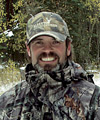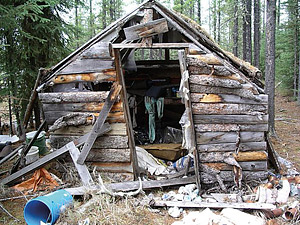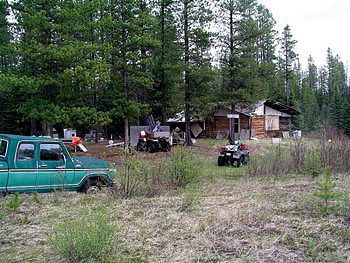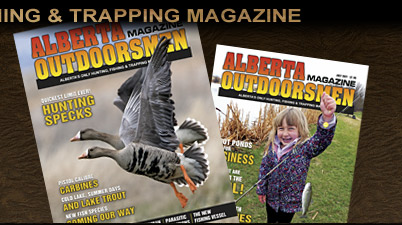|
 |
 |
I’m not sure how or when it all started but I’m guessing it was like a festering sore that just wouldn’t go away, eventually leading to the point where something had to be done to mitigate an unwanted end. The sore had been left too long, perhaps ignored because correcting the problem would likely bring it to the forefront, and nobody really wanted that. But then it just couldn’t be ignored any longer; people were starting to notice and it was getting ugly—it was surely going to leave a scar that would require corrective measures to repair.
And here we are today, where that scar is quite visible and quite ugly but still quite repairable if those in charge accept the challenge placed before them. Because there is no room here for dispute or petty differences; a 250 year history is at stake and with that an honourable time-proven, sustainable profession and invaluable knowledge that must be preserved at all costs.
And as such, in 2004 Sustainable Resource Development (SRD) began “working through a review and improvement process of trapping in Alberta.” There was little choice; fix it or get rid of it. Scary enough, getting rid of it was considered.
 |
| Abandoned? Apparently not, unless of course you read the Wildlife Act. |
It began more likely from complaints of abuse of trapline privileges where claims of traplines being purchased for uses other than trapping were being confirmed. Others had become mere eyesores, blights on the landscape and as such blind eyes were turned to their existence. Others were virtually abandoned, yet licences were renewed by Fish and Wildlife staff at leisure, regardless of mis-use.
And the Alberta Trappers Compensation Program, a program designed for compensating trappers for trapping business losses related to industrial activity on Registered Fur Management Areas (RFMA’s) and administered by the Alberta Trappers Association (ATA), had become a dinosaur that nobody wanted, at least not the administration of it in its current form.
Recognizing this, both SRD and the ATA sat in earnest and drafted the “Detailed Business Case for Alberta’s Trapping Program”. A paper that set before it a detailed path that would correct much of what was wrong and how trapping in Alberta should move forward in the 21st Century. And although no paper is perfect, this one is close. So close in fact, there is no reason I should be writing this column in its current context.
The “Business Case” is the end result of two separate working groups who were “charged with the responsibility of fully reviewing the fundamental policy and regulatory structure that is the foundation of today’s trapping industry in Alberta” and to review and recommend “how trapper compensation should be managed”.
The end result brought forward a proposal to “have the ATA take a larger role in Alberta’s trapping program through an expanded Memorandum of Understanding (MOU)”.
It would also give SRD, in conjunction with the ATA, further ability to remove delinquent RFMA holders and those who use traplines for purposes other than trapping through an active trapper designation that would be fully enforced, and those that failed to meet those standards would “be ineligible to hold a licence”.
According to Gordy Klassen, president of the ATA, there may be several hundred RFMA holders who would be in peril of losing their traplines, some immediately. And rightfully so. Both SRD and the ATA want real trappers on the ground managing the resource, not simply RFMA holders who probably couldn’t find their way across their RFMA if they tried.
The Business Case also lays out quite clearly the minimum standards by which a trapper would have to abide to retain his “active” status, including the submission of an RFMA plan by April 30th of each year that shows the trapper is active and utilizing his RFMA to its sustainable harvest potential. Fur harvest records that include the signing of a statutory declaration confirming the fur report is correct, must be submitted each year along with fur receipts/returns as well.
Trappers must also maintain a “minimum level of competency” that includes upgraded training, ultimately enhancing the image of trappers and their professionalism and “force non-trappers or inactive trappers to make decisions regarding their involvement in the program”.
And the illegal or inappropriate use of trapline cabins will come to an end as a minimum set of standards will be adopted and enforced.
 |
| Sights like this are soon to be a thing of the past. Notice the abandoned truck sunk in the muskeg. |
Funding for the new trapping program would become the responsibility of the ATA and would come from education and training fees, existing grants to the ATA and a liberal licence fee increase to RFMA holders from the current $40.00 to $300.00. The increase in monies to the ATA would be substantial but so too would be their responsibilities, which appears to be what everybody wants with the eventuality of a Delegated Administrative Organization (DAO) that would become the delivery tool for the new trapping program in Alberta. According to the ATA there would be enough funds to administer the program effectively, including the hiring of staff.
But for one reason or another the “Trapping in the 21st Century” train was derailed and now, six years later, that derailed train still sits idle and frustrations lay everywhere; from the Alberta Trappers Association through to Alberta’s Fish and Wildlife head office in Edmonton. In between are Fish and Wildlife enforcement officers, resident trappers with little to no hope for ever holding an RFMA without paying a King’s ransom, as well as registered trapline holders who have faced the wrath of a timber harvest that leaves them with little or no room left to trap on their current line, but stand by while their neighbour RFMA holder has little regard for trapping and ignores the rules in place within our Wildlife Act.
Many believe the derailment of the trapping train was brought about purposely by factions within SRD who would rather see trapping removed from the landscape. It is much easier to access public land for resource extraction when there isn’t a forest guardian standing in the way.
Others believe a dispute between biologists and trappers on how predator control should be undertaken may also be playing a part. It appears that groups like Defenders of Wildlife may have infiltrated the ranks of a respected biologist regime; perhaps growing a fear that their services may not be required should trappers institute their own programs with SRD encouragement.
As a resident trapper standing by and watching the turmoil unfold I can only shake my head. The program is in place and it’s a good one. But it can only be good if the dust gets kicked off the proverbial “paper” and maybe a few others standing in the way get kicked in the proverbial you know what.
Frustrated at my own lack of ability to secure a registered trapline without giving up my first born, I requested a meeting with both ATA president Gordy Klassen and Assistant Deputy Minister of SRD’s Fish and Wildlife Division, Dave England, a former fish and wildlife officer and an honourable man by any standards.
My hope was to explain the frustration many trappers feel when so many traplines across the province sit vacant or mis-used. The solution to many of the problems both the ATA and SRD face is a lack of legitimate trappers on the landscape. And it’s not as though there aren’t real trappers out there; they are there and they are ready and willing to step up to the plate under whatever guidelines are presented to them. They just need the support of their government—funny thing is that support already appears to be in place, it’s just never been given.
In our meeting we were told that trapping in Alberta would soon be sporting a new look and gone would be the pretenders and real trappers would soon be put back on the landscape. In fact England said he needed two months in which to set things right.
Coming from a man in Dave’s position I have new hope for trapping in Alberta. I know that the ATA is ready to move forward and have high hopes SRD is as well. I also believe that any differences can be worked out quickly, because I also believe that is exactly what everybody wants to see.
It’s time to put the train back on the track and get it rolling. The track is in place and the train is upright; we just have to fire up the engine. ■
For previous Outdoor Pursuits click here.
|
|
|
|


